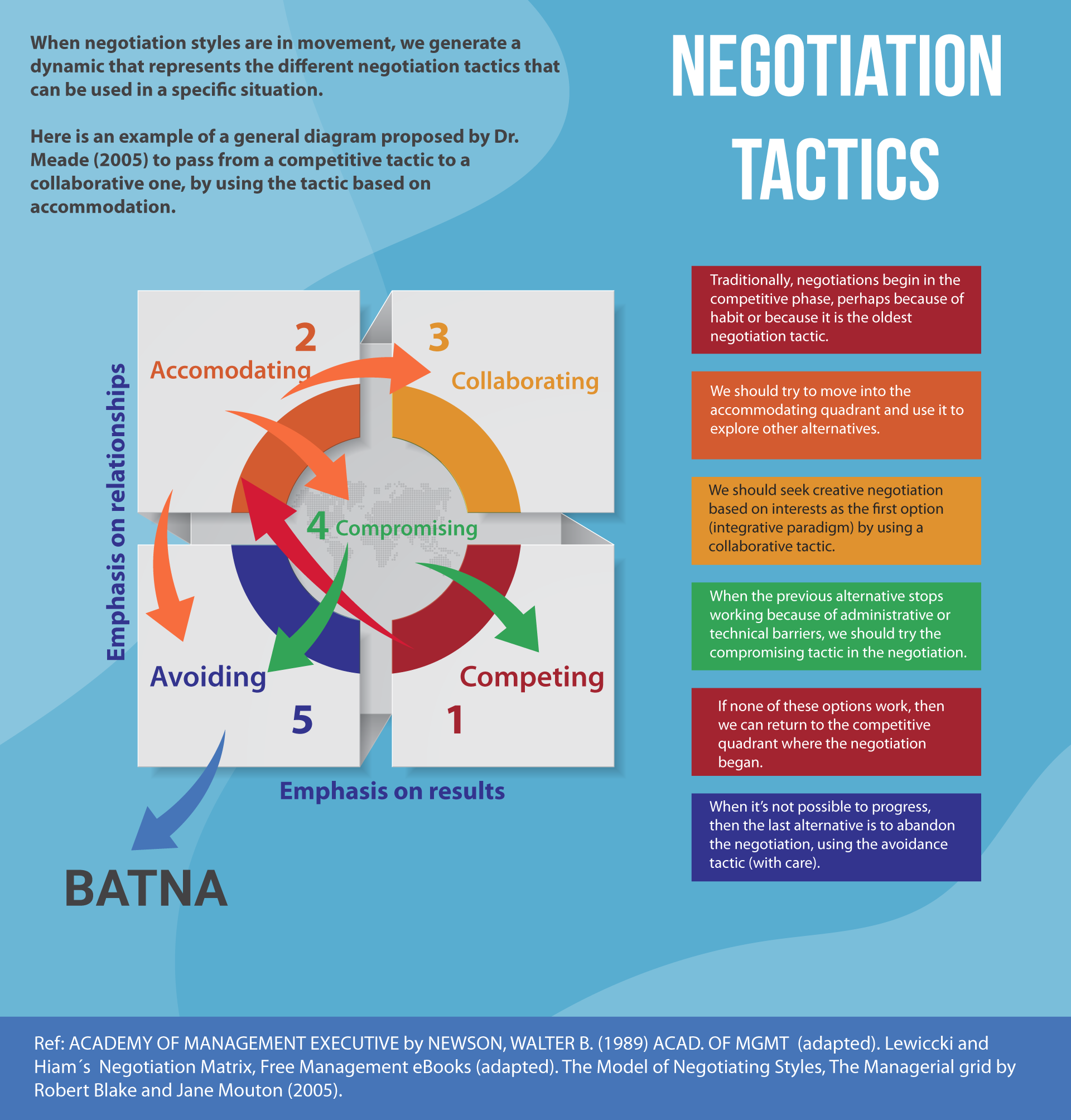Week 1 - Negotiation Styles and Tactics
This workshop on negotiation strategies and styles aims to help participants identify negotiation styles based on two key variables: the results of the negotiation and the relationships among the parties involved. These negotiation styles or profiles are behaviors that arise during negotiation and are influenced by one’s family and work culture. Recognizing one’s preferred negotiation style is essential as it significantly impacts the negotiation strategy and, consequently, the effectiveness of the agreement reached. The workshop outlines five negotiation styles:
- Competitive Style: This style emphasizes results without much regard for the relationships involved.
- Accommodating Style: This style places emphasis on maintaining relationships, often at the expense of the desired results, and is characterized by making concessions.
- Collaborative Style: This style aims to satisfy both key variables – achieving desired results while maintaining healthy relationships.
- Concluding/Terminating Style: This style represents a loss of interest in both variables, leading to a desire to conclude, terminate, or cancel a negotiation.
- Intermediate Style: Some authors mention this style, which seeks a balance between results and relationships, aiming for an agreement among negotiators.
The facilitator encourages participants to engage actively in the learning process, apply these concepts in various settings, including family and work environments, and explore new and powerful options for negotiation.
every negotiator has to consider two variables at the time of negotiating: results and relationships.
model of conflict resolution by Thomas Kilmann, which later evolved into the negotiation matrix of Lewicki and Hiam … rooted in “Dual Concerns Model” originally published by W.B. Newson
dual matrix, known also as the negotiation matrix by Lewicki and Hiam which includes the five negotiation styles: competitive, collaborative, accommodating, compromising, and avoiding.

Competitive
This is the oldest style that is known and corresponds to the dichotomy of “win-lose,” in other words, a person that uses this negotiation style seeks to impose his power at all cost on his “adversary” and take the greatest amount of the resource available. This style can work when the relationships are not considered relevant, and all that is wanted is a quick result. For example, the purchase/sale transaction of a used car.
- Win no matter what the cost
- Intimidate, pressure, humiliate,
- Distrust and hide information
- Antagonistic attitude.
- Business is business and time is of the essence
Collaborative
This is the most modern style of negotiation and it follows the behavior of collaboration and empathy, seeking mutual trust among the parties. There is a real concern for keeping productive, long-term relationships, and the focus is on solving complex problems. This style requires special skills, and investing time, and the results can often be amazing. This style is also known as “win-win.”
- Creativity and problem solving cost
- “Win-win” attitude
- Integrative solutions
- Synergy and empathy
- Relationships based on trust - Exploration of the parties’ interests
- When the talents of the parties complement each other in a context of paradigm shift.
- When what is wanted is to transform intangible values into spectacular results.
It requires a change in the mentality of the negotiators as well as special abilities such as assertiveness, consensus building, non-verbal language interpretation, creating open questions, and knowing how to manage the differences
Accommodating
This style is the opposite of competing, and seeks above all to keep the relationship among the parties, without concern for the short term results. This style is also known as “lose-win” or losing to win, which in reality means making concessions to save relationships when a conflict is threatening to turn into confrontation. The counterpart is encouraged to do the same, in order to resume the negotiation and seek alternatives to achieve mutually satisfactory agreements.
- Keep harmony and maintain the peace
- Good relationships get good agreements
- Avoid disagreeable confrontations
- Trust above all
- Concessions encourage good relationships
Hints for the accommodating style - Working with Concessions
concessions are a tactic of correspondence, when retribution is expected
- Make your concessions stand out, even if they are little things. Make sure to obtain something in exchange for every concession you make.
- Take your time and reflect on the situation before making concessions. Be the first to make a modest concession.
- Learn the needs and intentions of your counterpart first. Have the other party make an effort to achieve a concession.
- Keep a register of the concessions made so you can identify patterns.
- Don’t make frequent, quick, or substantial concessions. Be careful if you need to take back a concession.
Compromising
This style was known as gender-specific because it was originally adopted as an attempt to accommodate the typical characteristics of women for whom relationships were usually priority. Today, however, the style is not limited to women’s use, thanks to feminine and masculine leadership in business. It is a very useful style when a negotiation cannot move forward for some reason, usually technically, and the negotiators decide to take as much as they have achieved up to that point, with the priority of keeping the relationship no matter what. This style is also known as splitting the difference.
- Split the difference
- Agreement halfway there
- Attitude of neither “you nor I”
- Interchange and balance in the proposals
- “give and take”
It is good to use this negotiation tactic when:
- What is desired is an agreement that is acceptable to both parties since they have a similar power to negotiate.
- There is a “mixed” negotiation system of competition/collaboration.
- It can lead to suboptimal results and requires a compromise by both parties.
Avoiding
This style is novel and useful even when it is known as “lose-lose.” In reality, it’s an important, beneficial style when you wish to end the process of negotiation, not caring about results or relationships This can occur when, for example, there is a technological disruption that nullifies the previous initiatives in a negotiation, or when the BATNA improves the objectives of the negotiation. This style should only be used with caution.
- Indifference and resignation
- Keep a low profile
- I can’t do anything to change the situation
- Take what you can and leave
- Give up, forget, resign
It is a valuable resource when all the options and time have run out, and the amount of resources invested outweighs the results expected
Sometimes, the same person can have several styles of negotiation, and that negotiation profile is called “eclectic.”

Negotiation tactics
In this section, the importance of negotiation styles is explored further, focusing on the consequences and implications of each style on the outcome of a negotiation. The concept of “negotiation tactic” is introduced to represent “styles in action” that leverage the strengths of each style. Examples are provided to illustrate the application of different styles in various contexts:
-
Workplace Scenario:
- A colleague opens a window in winter, causing a cold draft and noise, which bothers another colleague.
- Using a competitive style, the bothered colleague could close the window and explain their conflicting reasons, initiating a win-lose or possibly lose-lose dynamic.
- Adopting a compromise-based style, they could agree to open the window at specific times and close it at others to maintain a harmonious relationship.
- Using an accommodating style, they might rearrange the desks to mitigate the cold draft and noise.
-
Selling a Used Car:
- In an urgent need to sell a deteriorated car to buy a new one due to a dealer’s promotion, the seller receives an offer below the appraised value.
- Given the time-sensitive nature and lack of interest in a long-term relationship with the buyer, a competitive negotiation style might be most appropriate in this one-dimensional negotiation.
-
Community Pollution Problem:
- A neighborhood facing pollution issues considers buying and planting trees to improve air quality.
- There is a significant opportunity for a collaborative style, as neighbors could work together on selecting tree species, sharing costs, and caring for the trees.
The examples illustrate how every negotiation involves a balance of results and relationships, and offers five options for negotiation: competitive, collaborative, accommodating, compromising, and abandoning the negotiation if necessary. The section encourages readers to explore and apply these various negotiation styles and tactics based on the situation at hand.
[[aAJxjWGQRTKCcY1hkFUykA_8a8bfe5713b94f3baba0c765c46c6894_Negotiation-Tactics.pdf|Negotiation tactics]]
Negotiation is not a conflictive process among adversaries, but rather a coalition to solve a complex problem by taking advantage of the resources and competencies of all of the negotiating parties.
When this tactic is abused, it can create conflicts that escalate into confrontations, even with permanent damage to the relationships among the negotiators.
similar to the distributive paradigm in the sense that all that matters are the positions and there is no inclination to explore the underlying interests in a negotiation
when there has been too much antagonism because of a purchase/sale, the Reciprocity Principle can be used to make a small exploratory concession and wait until the other party corresponds
Steps in a negotiation
- Traditionally, negotiations begin in the competitive phase, perhaps because of habit or because it is the oldest negotiation tactic.
- We should try to move into the accommodating quadrant and use it to explore other alternatives.
- We should seek creative negotiation based on interests as the first option (integrative paradigm) by using a collaborative tactic.
- When the previous alternative stops working because of administrative or technical barriers, we should try the compromising tactic in the negotiation.
- If none of these options work, then we can return to the competitive quadrant where the negotiation began.
- When it’s not possible to progress, then the last alternative is to abandon the negotiation, using the avoidance tactic (with care).
Negotiation quadrant
Negotiation quadrant - also showing the order for applying Negotiation Tactics

Linking
- ➡ Week 2 - The Implementation Strategy
- ⬅ Module 2 - Week 4 - Conflict resolution